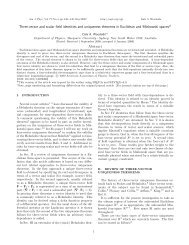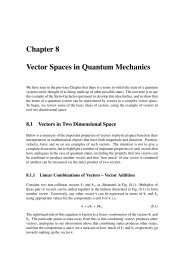Electrostatic Fields in Matter
Electrostatic Fields in Matter
Electrostatic Fields in Matter
You also want an ePaper? Increase the reach of your titles
YUMPU automatically turns print PDFs into web optimized ePapers that Google loves.
This could all get confus<strong>in</strong>g!Remember• ɛ will be a very small number (s<strong>in</strong>ce ɛ 0 = 8.84 × 10 −12 ).• Relative permittivity and dielectric constant are the same th<strong>in</strong>g,with values usually between 1 and 100 (although 50,000 is possible).• χ e is one less than ɛ r . (So what is its value for free space?).8 Electric DisplacementThe differential form of Gauss’s law is:∇ · ⃗E = ρ ɛ 0(17)We now th<strong>in</strong>k of the charge as two parts: ρ = ρ f + ρ b .This means that ∇ · ⃗E = ρ f + ρ bɛ 0= ρ f − ∇ · ⃗Pɛ 0and this gives us ∇ · (ɛ 0⃗ E + ⃗ P ) = ρf (18)We now def<strong>in</strong>e a new quantity, the electric displacement vector⃗D, def<strong>in</strong>ed as⃗D = ɛ 0⃗ E + ⃗ P (19)(This also means that ⃗ D = ɛ ⃗ E) (20)We then have ∇ · ⃗D = ρ f (21)We can th<strong>in</strong>k of equation (21) as Gauss’s law <strong>in</strong> a dielectric.9
















